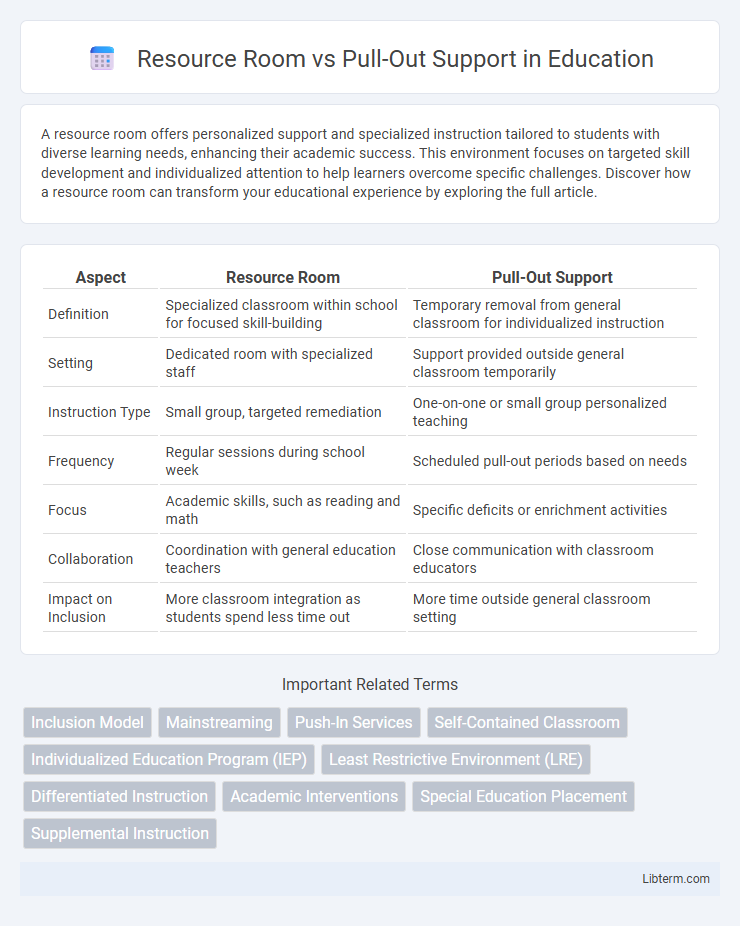A resource room offers personalized support and specialized instruction tailored to students with diverse learning needs, enhancing their academic success. This environment focuses on targeted skill development and individualized attention to help learners overcome specific challenges. Discover how a resource room can transform your educational experience by exploring the full article.
Table of Comparison
| Aspect | Resource Room | Pull-Out Support |
|---|---|---|
| Definition | Specialized classroom within school for focused skill-building | Temporary removal from general classroom for individualized instruction |
| Setting | Dedicated room with specialized staff | Support provided outside general classroom temporarily |
| Instruction Type | Small group, targeted remediation | One-on-one or small group personalized teaching |
| Frequency | Regular sessions during school week | Scheduled pull-out periods based on needs |
| Focus | Academic skills, such as reading and math | Specific deficits or enrichment activities |
| Collaboration | Coordination with general education teachers | Close communication with classroom educators |
| Impact on Inclusion | More classroom integration as students spend less time out | More time outside general classroom setting |
Introduction to Resource Room and Pull-Out Support
Resource Room provides specialized instruction within a dedicated classroom setting, offering targeted support tailored to students with learning disabilities or challenges. Pull-Out Support involves temporarily removing students from general education classrooms for individualized or small group instruction to address specific academic needs. Both approaches aim to enhance student learning through personalized interventions in varying educational environments.
Defining Resource Room: Core Features
Resource rooms provide specialized, structured environments where students with disabilities receive individualized instruction tailored to their IEP goals in subjects like reading, math, and writing. These rooms feature smaller class sizes, specialized staff such as special education teachers, and adaptive technology to support diverse learning needs. The core features emphasize personalized support, skill reinforcement, and targeted interventions within a focused setting.
What Is Pull-Out Support? Key Elements
Pull-out support is a targeted instructional strategy where students are temporarily removed from their general education classrooms to receive specialized teaching in a smaller setting, focusing on specific skill deficits. Key elements include individualized or small-group instruction, collaboration between special educators and general teachers, and alignment with the student's Individualized Education Program (IEP). This approach aims to provide tailored support to enhance academic achievement while allowing students to reintegrate into the mainstream classroom.
Differences in Structure and Setting
Resource rooms provide specialized instruction within a dedicated classroom where students receive targeted academic support from special education teachers. Pull-out support involves temporarily removing students from their general education classroom to work individually or in small groups with specialists in a separate setting. The key difference lies in the environment and delivery: resource rooms offer a consistent, structured space focused on individualized learning, while pull-out support is more flexible and integrated with the general education schedule.
Target Students: Who Benefits from Each Approach
Resource rooms primarily benefit students with mild to moderate learning disabilities who need targeted instruction in a controlled, distraction-free environment while remaining part of the general education setting. Pull-out support suits students requiring specialized, individualized assistance in specific subjects or skills outside the general classroom, offering focused intervention without full removal from mainstream peer interaction. Both approaches aim to enhance academic achievement for students with special education needs while balancing inclusion and personalized support.
Instructional Methods and Teaching Strategies
Resource Room instruction employs specialized small-group settings where educators use targeted, individualized teaching strategies such as multisensory approaches and scaffolded lessons to address specific learning needs. Pull-Out Support involves temporarily removing students from the general classroom for focused intervention, emphasizing tailored instruction that reinforces classroom content and builds foundational skills through direct, explicit teaching methods. Both approaches prioritize differentiated instruction but differ in setting and intensity to optimize student engagement and mastery.
Role of Special Education Teachers
Special education teachers in resource rooms provide targeted, individualized instruction within a specialized classroom setting tailored to students' unique learning needs, allowing for consistent progress monitoring and skill development. In pull-out support, these teachers offer focused interventions by temporarily removing students from the general education classroom to work on specific academic or behavioral goals, ensuring personalized assistance while maintaining integration in the mainstream environment. Both roles emphasize specialized instructional strategies, collaboration with general education teachers, and ongoing assessment to support students with disabilities effectively.
Impact on Academic and Social Development
Resource Room services provide targeted, intensive support within a structured setting, enhancing students' academic skills through specialized instruction that promotes confidence and independence. Pull-Out Support allows students to receive individualized assistance outside the general classroom, fostering skill development while encouraging social interaction with peers during regular class time. Both models improve academic outcomes, but Resource Rooms may offer greater consistency in skill reinforcement, whereas Pull-Out Support balances academic needs with social inclusion.
Pros and Cons: Resource Room vs Pull-Out Support
Resource Room support offers targeted instruction in a specialized setting, allowing students to receive personalized attention while remaining connected to their general education curriculum; however, it may limit exposure to peer interactions and broader classroom experiences. Pull-Out Support provides focused, individualized help by temporarily removing students from regular classes to address specific learning needs, enhancing skill development but potentially causing disruptions and missed content in core subjects. Choosing between Resource Room and Pull-Out Support depends on balancing the benefits of specialized intervention with the importance of inclusion and continuity in the general education environment.
Choosing the Best Support Model for Student Needs
Resource Room provides specialized instruction within a dedicated classroom, allowing students to receive targeted support in core subjects while maintaining social interaction with peers. Pull-Out Support offers individualized or small-group tutoring outside the general education classroom, promoting focused intervention tailored to specific learning challenges. Selecting the best support model depends on student needs, including the severity of learning difficulties, social integration goals, and the level of personalized attention required for academic progress.
Resource Room Infographic

 libterm.com
libterm.com